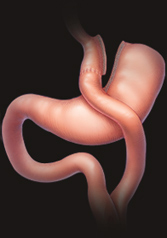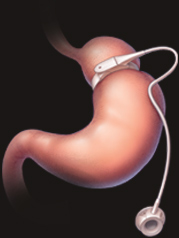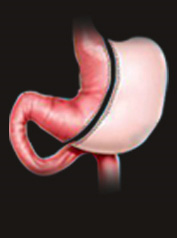| |
 |
 |
 |
| |
Gastric Bypass |
Gastric Banding |
Sleeve Gastrectomy |
| Procedure |
- Minimally invasive laparoscopic procedure involving multiple areas of the abdomen changes normal process of digestion
- Not reversible
|
- Minimally invasive laparoscopic procedure no stomach stapling, cutting or intestinal re-routing
- Reversible
|
- Minimally invasive laparoscopic procedure requires stapling
- Not reversible
|
| |
|
|
|
| Implanted Device |
- No significant hardware in body
|
- Requires implanted medical device
|
- No significant hardware in body
|
| |
|
|
|
| Advantages |
- Rapid initial weight loss
- Slightly increased total weight loss
- Improved or resolved conditions associated with obesity
- Improved quality of life
- Low mortality rate
- Low complication rate
|
- No change to normal digestion or nutrient absorption
- Lower risk of surgical complications
- No Dumping Syndrome 1
- Lowest mortality rate
- Improved or resolved conditions associated with obesity
- Improved quality of life
|
- Suited for patients with health conditions that do not make them good candidates for other weight loss surgeries
- Leaves stomach openings intact so digestion occurs normally
- Lower risk of surgical complications
- No Dumping Syndrome 1
- Improved or resolved conditions associated with obesity
- Improved quality of life
|
| |
|
|
|
| Risks or Complications |
- Changes normal digestion
- Staple separation or leakage
- Potential inability to see some organs with x-ray or endoscopy
- Ulcers
- Dumping syndrome 1
- Increased gas
|
- Band may slip, leak or erode port may dislodge
- Tube and port complications (kinking, infection and disconnection)
- Esophageal spasm
- Gastroesophageal reflux disease (GERD)
- Inflammation of the esophagus of stomach
|
- Staple separation or leakage
- Ulcers
- Dyspepsia (upset stomach or indigestion)
- Esophageal dysmotility
- Fistula (an abnormal connection between organs or vessels)
|
| |
|
|
|
| Recovery |
Normal activity within one week; full recovery within two to four weeks |
Normal activity within one week; full recovery within two to three weeks |
Normal activity within a few days; full recovery within two to four weeks |
| |
|
|
|
| Follow-Up |
Regular follow up to track Progress |
Regular follow up to and adjustments necessary for best results |
Regular follow up to track progress |
| |
|
|
|
| Weight Loss |
Rapid weight loss over 3-6 months, settling at final weight 18-24 months after surgery |
Slow and steady weight loss setting at final weight around five years after surgery |
About 50% of desired weight loss
within two years; about 80% of
desired weight loss at about three
years. Patients with a BMI > 60 may
require additional malabsorptive
procedure to achieve total weight loss
goal. |
1. An intolerance to sugars, fats and some carbohydrates frequently developed after gastric bypass. Patients may experience nausea, flashing and sweating, light headedness and watery diarrhea. These risks can be significantly reduced by following your dietitian’s guidelines very carefully, especially during the first two months after surgery.